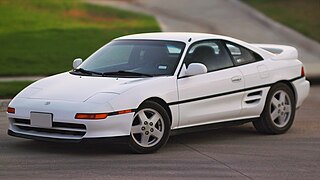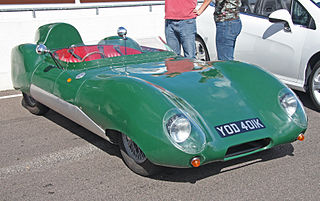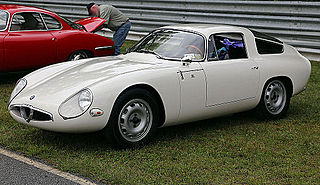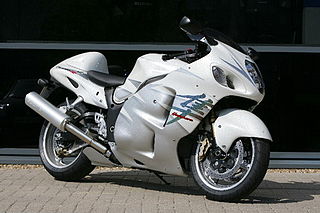
The Reliant Kitten is a small four-wheeled economy car which was manufactured from 1975 to 1982 in saloon, van and estate variants by the Reliant Motor Company in Tamworth, England. It was the company's second four-wheeled car to reach production, following the Reliant Rebel of 1964.

The Ford Galaxie is a full-sized car that was built in the United States of America by Ford for model years 1959 through to 1974. The name was used for the top models in Ford's full-size range from 1958 until 1961, in a marketing attempt to appeal to the excitement surrounding the Space Race. For 1962, all full-size Fords wore the Galaxie badge, with "500" and "500/XL" denoting the higher series. The Galaxie 500/LTD was introduced for 1965 followed by the Galaxie 500 7-Litre for 1966. The Galaxie 500 prefix was dropped from the LTD in 1966, and from the XL in 1967; however the basic series structuring levels were maintained. The "regular" Galaxie 500 continued below the LTD as Ford's mid-level full-size model from 1965 until its demise at the end of the 1974 model year.

The Chevrolet Corvair is a compact car manufactured by Chevrolet for model years 1960–1969 across two generations. As the only American-designed, mass-produced passenger car with a rear-mounted, air-cooled engine, the Corvair was manufactured and marketed in two-door coupe, convertible, four-door sedan, four-door station wagon, passenger van, commercial van, and pickup truck body styles in its first generation (1960-1964) as well as two-door coupe, convertible and four-door sedan in its second generation (1965-1969).
Westfield Sportscars are manufacturers of both factory built and kit versions of several two-seater, open top sportscars. Their main product line is a Lotus Seven inspired car - vehicles originally designed by Colin Chapman with only the bare essentials for motoring in order to give the rawest and most exhilarating driving experience.

The Toyota MR2 is a two-seat, mid-engined, rear-wheel-drive sports car manufactured in Japan and marketed globally by Toyota from 1984 to 2007 over three generations: W10 (1984–1989), W20 (1990–1999) and W30 (2000–2007). It is Japan's first mid-engined production car.

The Ford LTD is a range of automobiles manufactured by Ford Motor Company for the 1965 to 1986 model years. Introduced as the highest trim of the full-size Ford model range, the LTD introduced options and features normally reserved for more luxurious Lincoln and Mercury models. The largest vehicle produced by Ford in North America for most of its production, the LTD was joined by the intermediate Ford LTD II from 1977 to 1979; the LTD II served as the replacement for the Torino/Gran Torino range. At various times throughout its production, the LTD range included two- and four-door pillared and hardtop sedans, a two-door convertible, and the Country Squire five-door woodgrain station wagon.
Shannon Racing Cars was a Formula One constructor from the United Kingdom with Aiden Jones, formerly a mechanic for Prince Bira and Prince Chula, and Paul Emery as the principals. Using a car built by former Emeryson designer Emery and an old Coventry Climax engine, they participated in a single Grand Prix. Trevor Taylor drove for the team at the 1966 British Grand Prix, retiring early in the race. The car was then used for Formula 3 until 1969.

An anti-roll bar is a part of many automobile suspensions that helps reduce the body roll of a vehicle during fast cornering or over road irregularities. It connects opposite (left/right) wheels together through short lever arms linked by a torsion spring. A sway bar increases the suspension's roll stiffness—its resistance to roll in turns, independent of its spring rate in the vertical direction. The first stabilizer bar patent was awarded to Canadian inventor Stephen Coleman of Fredericton, New Brunswick on April 22, 1919.

Maserati Ghibli is the name of three different cars produced by Italian automobile manufacturer Maserati: the AM115, a V8 grand tourer from 1966 to 1973; the AM336, a V6 twin-turbocharged coupé from 1992 to 1997; and the M157, an executive saloon from 2013 onwards.

Formula Mazda is a class of relatively affordable open wheel formula racing.

The Fiat Argenta is a large family car produced by the Italian automobile company Fiat from 1981 to 1985. It was a comprehensive update of the Fiat 132 and the last mass-produced Fiat with rear-wheel drive until the 2016 124 Spider. The change to a name came about as Fiat was changing their naming strategy, changing from three-digit numbers to more meaningful names. This model was available in sedan/saloon bodystyle only.

The Westfield XI is a British sports car and kit car based on the Lotus Eleven.
The Spectre R42 is a 2-seater mid-engined rear-wheel drive sportscar manufactured by British boutique automobile manufacturer Spectre Supersports Ltd.
In motorsport, the racing setup, car setup or vehicle setup is the set of adjustments made to the vehicle in order to optimize its behaviour for specific conditions. Vehicle setups are variable for a variety of reasons, ranging from weather, driver/rider preference and race track characteristics. Contrary to common misperceptions, setup is not used to maximize the performance of the engine, but to optimize it for the track at which it is being used. For example, motorcycle racers frequently detune their engines to reduce performance and power output so as to ensure the bike accelerates in a predictable manner.
Sylva Autokits is a kit car manufacturer based in Lincolnshire, England. Sylva was founded in 1981 by Jeremy Phillips and has developed and produced a number of small and lightweight sports cars. Sylva cars have proven very successful in competition, winning a number of 750 Motor Club Kit Car championships.

The Alfa Romeo Giulia TZ was a sports car and racing car manufactured by Alfa Romeo from 1963 to 1967. It replaced the Giulietta SZ. In 2011, the name was reduced from Giulia TZ to TZ in the new TZ3 model.
Alfa Romeo offered the opportunity for a limited number of enthusiasts to participate in a race on the track with the GTV 3.0. After a sports-car driving course by Andrea de Adamich participants were ready to manage 230 horsepower.
The Audi R8 LMS Cup is a one-make sports car racing series by Audi based in Asia. Audi R8 LMS Cup cars based on the Audi R8 LMS(GT3).

The Nissan GT-R LM Nismo was a sports prototype racing car built by the Nissan Motor Company and their motorsports division Nismo. Designed for the Le Mans Prototype 1 Hybrid (LMP1-H) regulations of the FIA World Endurance Championship and the 24 Hours of Le Mans, the GT-R LM was unique amongst Le Mans Prototypes at the time for utilizing a front mid-engine layout for its internal combustion engine, as opposed to the rear mid-engine layout used by nearly all other competitors in the category. It was Nissan's first prototype since the R391 competed in 1999, although the company had supplied engines in recent years. The car was branded after the Nissan GT-R road car and shares similar engine and drivetrain configurations, but is not related to the sports car. The GT-R LM Nismo program was announced on 23 May 2014, while the car was publicly shown for the first time in a Nissan commercial during Super Bowl XLIX on 1 February 2015. It was retired from competition at the end of 2015, after having competed in only one race.

The Brabham BT62 is a mid-engined track day car produced by Anglo-Australian car manufacturer Brabham Automotive. It was introduced in 2018 with deliveries expected to start at the end of that year. A planned production of only 70 cars is intended, in honour of the company's 70 year heritage in racing.
















